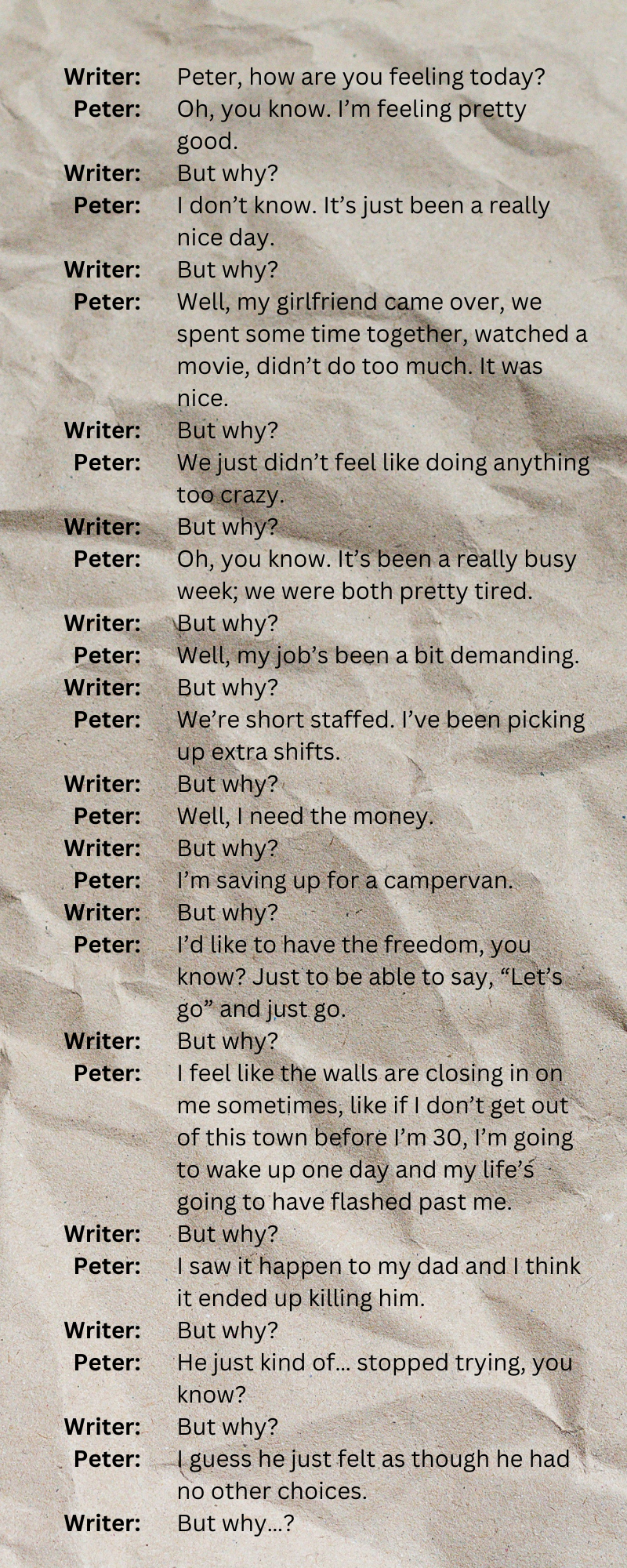How to create depth and engagement... by acting like a two-year-oldThis is the hill I will die on: great characters can paper over a flimsy plot, but a great plot can’t disguise underdeveloped characterisation. Characters are the most important tool in a writer’s arsenal. They’re the mechanism through which a reader enters your world; they’re the vehicle through which your reader will travel the narrative journey you’ve laid out. They don’t have to be likeable (CF: Heathcliff and Cathy in Wuthering Heights, who are just relentlessly awful to everyone they meet, and still manage to take the top spot in a poll of literature’s greatest lovers) and we absolutely do not have to agree with everything they say or do. But they must be recognisable. By “recognisable,” I mean that we should be able to infer from their speech and actions that every decision they make is underpinned by a rich, layered history that includes formative experiences, background and upbringing, worldview, and all the decisions that have led to this point. Most of that information will never be directly available to your reader, and that’s as it should be. It’s unlikely that your tale of swashbuckling space cowboys rampaging through the galaxy will be enriched by a flashback to your protagonist’s childhood where we meet his extended family, his guinea pigs, and his favourite teacher (the one who really encouraged him to develop his love of piracy). But if you, the writer, don’t know this stuff, you can’t know how this stuff impacts on your character. No choices are ever made in isolation. They’re the product of a whole lot of context, much of which we keep tucked away in our subconscious thought processes, and in order to make sure your character is acting on the basis of who they are and not what your plot needs them to do, you’re going to have to tap into their subconscious. Yes, that’s going to take a little bit of effort. But the results will be worth it. And the good news is, there are some really easy ways to get started. I’ve written elsewhere about how to get to know the details that make up your character’s very specific mindset. Character factsheets can be a great jumping off point for discovering what you don’t know. Freewriting works better for some writers (me included), though I’d strongly suggest that you keep a separate document in which you pull out important factual information – date of birth, sibling names and birth order, that sort of thing – that you uncover along the way. And when you’re ready to uncover the beating heart of what motivates and terrifies your character, pushes them forwards and holds them back, it’s time for “But why?” I’ve been using “But why?” for many years now and there’s honestly no other exercise I know of that has the capacity to transform my understanding of a character so completely and so quickly. It looks ridiculous at first sight. Believe me, that sceptical expression you’re about to do as you read a bit further? I’ve seen it before. Plenty of times. Pretty much every time I’ve suggested it to a client or a member of one of my classes, in fact – and yet, it has never failed. Sometimes, the simplest path is the most powerful. Toddlers clearly know this, because “But why?” riffs shamelessly on their preferred method for information gathering, and is at least as effective in wearing down its subject. It works like this. Choose the character whose depths you’d like to explore. Address them by name, and ask them how they’re feeling today. Answer as your character. And every time you get a response, follow it up with, “But why?” Continue until you hit a brick wall (in which case, circle back to the most recent open-ended answer and try again), or until the magic happens. You’re about to discover stuff about your character that you never suspected. Here’s an example of how the exercise might play out: …And now we’re into some really powerful character stuff. Formative, bones-deep ideas, impressions, fears, that feed into the very heart of what motivates your character to make the choices they make. Peter, by the way, is not a character in any of my current projects. It’s a name I pulled out of thin air for the purposes of illustrating the exercise. With every new iteration of “but why?” I was getting to know this character completely from scratch. Look where it took me. A character that didn’t even exist until 5 minutes ago now has a girlfriend, a job, an aspiration, a tangible goal, a late father, a terrible fear, and a burning motivation. All because I continually pestered him about the lovely day he’d been having. Now imagine what it can do for the guys in your work in progress. Or, better yet: give it a go and find out for yourself.
2 Comments
RB Kelly
2/5/2023 09:32:34 am
Ah brilliant - I'm so glad you found it useful! Let me know how you get on with it :-)
Reply
Leave a Reply. |
Tips, tricks & advice to help your writing shineCategories
All
Blog updates on the first of every month.
|


 RSS Feed
RSS Feed